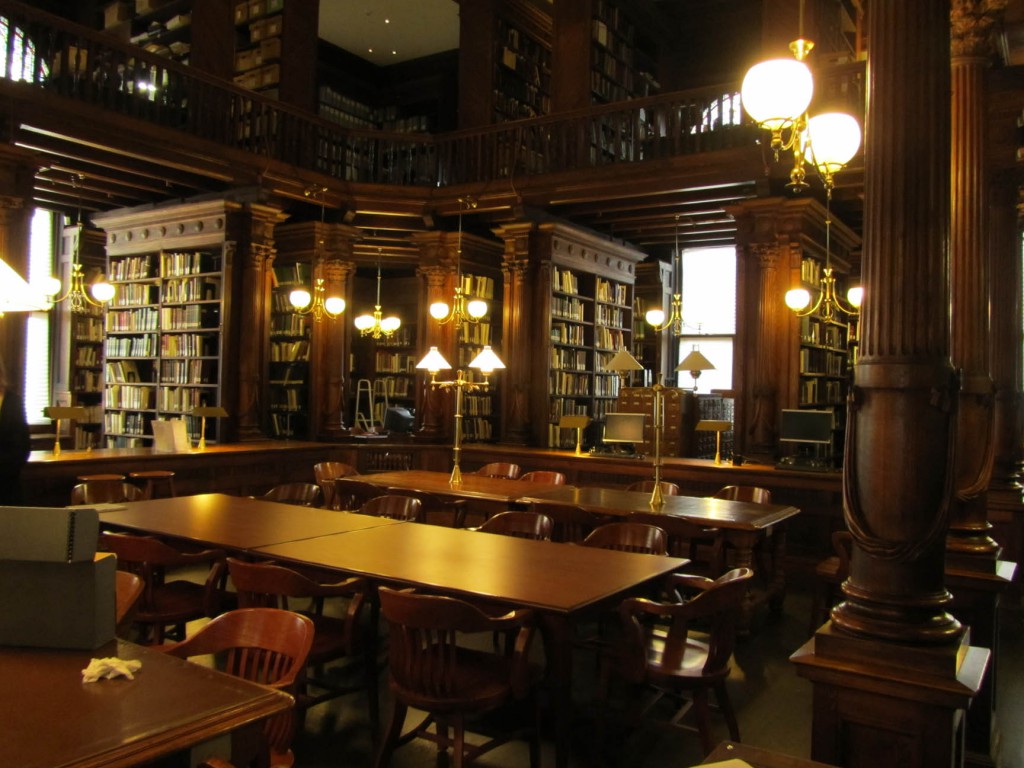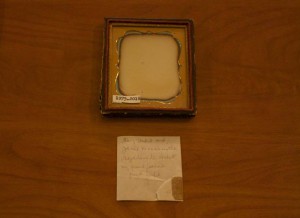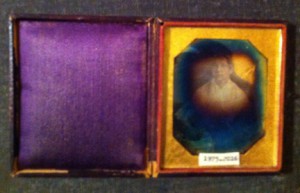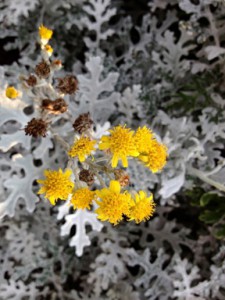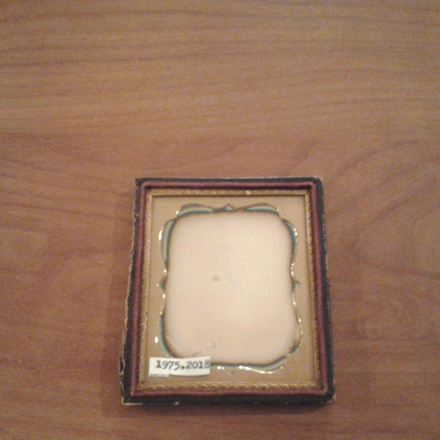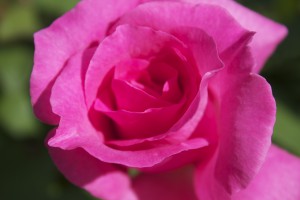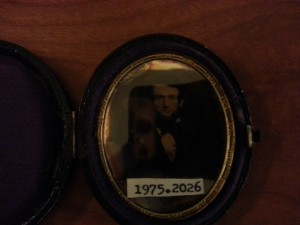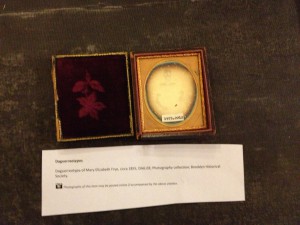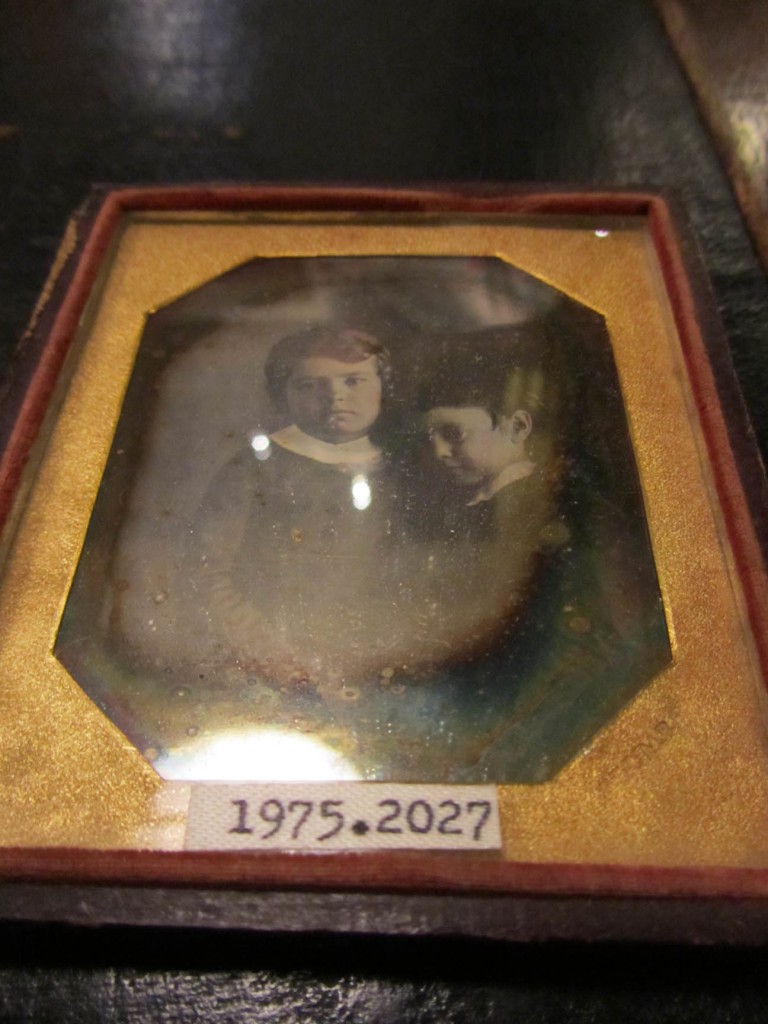 The daguerreotype I examined at the Brooklyn Historical Society was a portrait of two young boys. Since I have not yet taken a portrait this semester, it is difficult to compare the content of the daguerreotype and one of my own from this semester unless I were to compare with one of the statues that I photographed, and still that would not be the same. Therefore I feel the best way to compare a daguerreotype to a contemporary photo, is in physical characteristics and the process. The daguerreotype was a quarter plate size, I believe, making it approximately 3.25 x 4.25 inches. It was a copper plate, which made it reflective, encased in a frame with matting to protect it and had a decent amount of weight to it. By contrast any of the digital images I’ve taken this semester weigh nothing until I decide to print them out and then they weight only as much as the paper they are printed on. My digital images have a maximum print size of 18 x 24, but can be printed at any smaller size and I can print it as many times as I would like. The daguerreotype however could not be reproduced or resized at all as it was a unique image. I very much enjoyed the trip to the Brooklyn Historical Society, it was interesting and the library itself is architecturally beautiful.
The daguerreotype I examined at the Brooklyn Historical Society was a portrait of two young boys. Since I have not yet taken a portrait this semester, it is difficult to compare the content of the daguerreotype and one of my own from this semester unless I were to compare with one of the statues that I photographed, and still that would not be the same. Therefore I feel the best way to compare a daguerreotype to a contemporary photo, is in physical characteristics and the process. The daguerreotype was a quarter plate size, I believe, making it approximately 3.25 x 4.25 inches. It was a copper plate, which made it reflective, encased in a frame with matting to protect it and had a decent amount of weight to it. By contrast any of the digital images I’ve taken this semester weigh nothing until I decide to print them out and then they weight only as much as the paper they are printed on. My digital images have a maximum print size of 18 x 24, but can be printed at any smaller size and I can print it as many times as I would like. The daguerreotype however could not be reproduced or resized at all as it was a unique image. I very much enjoyed the trip to the Brooklyn Historical Society, it was interesting and the library itself is architecturally beautiful.
Category Archives: Photography Formats
Daguerreotype vs. Digital
Filed under Photography Formats, Uncategorized
Brooklyn Historical Society
**Note I don’t have a picture of my daguerreotype because my phone didn’t save it so I can’t compare my personal picture with a daguerreotype**
The Brooklyn Historical Society was a great place to be. I love places with books, no matter what they are, stores, rooms in buildings, I love places with books and not only did this place have books, but they had some great pictures and vintage or antique stuff.
One of the photo’s I looked at was a daguerreotype. It’s a photo that goes through a long process and the picture took a long time to make. It’s burned somehow into copper or some other form of metal. It needs to be viewed in a certain light. Now a big difference between pictures I’ve taken and a daguerreotype photo is, mine can be spontaneous, in motion, and its in color. Daguerreotype as mentioned go through a process. The subject or model has to stay perfectly still for a certain amount of time and can’t move because if they do, the photo will be messed up and will not come out were as with a digital camera from a phone, I can catch people in motion and the picture will still come out good.
Filed under Photography Formats
Brooklyn History Sociaty
Our second trip with the class. The Brooklyn Historical Society. First time for me in this place. Beautiful library. Classic. With this visit people can observe, in this particular case, how different was photography in the 1800´s and how is in the present.
The daguerreotype, a direct-positive process, was created with a long and tedious method. This, included polished a plate, mix chemicals, transfer to the cameras, mix some other chemicals, and so on. All of this involved hours and hours of time. Today, taken and printing a photograph is simpler. People with a digital camera or even with a dSLR, they just need to snap the object, person or whatever they want to shoot, and you can see it right on the screen. If you like your picture, you keep it and just go to the store and they will print it for you. Depends of the paper and some specifications, you can have the pictures right away in your hands.
Daguerreotype was a classic object that people used to decorate their homes. And was more for portraits than objects or landscapes. Today, they look classic and amazing but, definitely is easier the process of photography now. We have options in cameras, colors, black and white, and hundreds of effects that we can use with our pictures to make them look amazing and originals.
Filed under Photography Formats, Uncategorized
Learning Log 4
Daguerreotype of Amelia Farrington, Circa 1855, DAG 05: Photography collection; Brooklyn Historical Society
As we went to the Brooklyn Historical Society, I found out the daguerreotype becomes very delicate throughout the years and the images can disappear. We learned that the Daguerreotype is a positive process that is created with a metal plate that was developed over hot mercury until an image is appeared. The Daguerreotype I handled at BHS was a photograph of a woman that was taken in the mid 1970’s. The photograph looks like its fading away but the image was still clear, it also was an inverted colored image. It was very difficult to view the image from far away but to see it clearly I had to view it closely. Between Daguerreotype and Photography taken today, I believe are similar because it’s a long process to make the Daguerreotype and using the cameras today it doesn’t take that long but to get it just perfect it will take some time. Surprisingly, the photograph was very detailed just like the photographs that are taken today. The photograph I have taken this semester is similar to the Daguerreotype, Amelia Farrington. It is not exactly an inverted colored image but my photograph is positive space as shown and it is also very detailed.
Filed under Photography Formats, Uncategorized
Brooklyn Historical Society
Daguerreotype of Magdalena Hulst, circa 1855, DAG.09; Photography collection; Brooklyn Historical Society.
Digital Photograph taken at the Brooklyn Botanical Garden.
I personally think that the trip to the Brooklyn Historical Society taught me many new things, especially about daguerreotype photographs. It was exciting to know that we were able to see the daguerreotypes up close. Daguerreotypes are really different from digital photographs. Daguerreotype pictures are pictures that were made with chemicals and the pictures appear on metal plates. When I viewed one of the daguerreotypes, at first you couldn’t see the image, but when I viewed the picture on a different angle, I saw an image of a young woman sitting down. Digital photography is such a dramatic change from daguerreotype. Digital photographs are a stark images with vivid colors, yet daguerreotypes are images that you have to take time to look at to see what they really are, and the decorative frames that they put around these small images are beautiful, and seemed like it took a lot of time to create. This shows the difference of photography and the difference of how much goes into developing a photograph from the 1800’s to now. Overall our visit to the Brooklyn Historical Society was like a step back into the past, and it was a great to view the different daguerreotype pictures.
Filed under Learning Logs, Photography Formats
The Brooklyn Historical Sociaty
In the following paper, I will make several observations about the significant differences between “Danguerrereotype” picture and a digital photograph.
The “Danguerrereotype” picture does not offer vivid details to the viewer, anywhere close to the level of Digital photography. These pictures are in black and white or solid colors which are in direct contrast to today’s modern digital photography which allows for the full spectrum of color. In fact, in many cases it almost seems to be a cloud and there is an aura around the subject matter of the picture. These qualities do not allow for a completely accurate representation of the person or subject matter, in the same manner that a digital photograph would. However, the same qualities which might make the picture look less representative of the subject matter also add an artistic appeal to the picture. This is especially true when viewing “Danguerreotype” pictures of people. These black and white representations of people seem to capture the soul of the person but not necessarily does the viewer feel like they are looking at the person himself. When a person views a picture of a person that is taken digitally, you can see that person’s outward appearance in plain and sometimes painstaking detail. It is the same as seeing a person in passing on the street or at a restaurant. The “Danguerreotype” picture makes the viewer feel like you are viewing something spectral…”real” but “other worldy”. That is what makes the “type” pictures appeal to me against digital photography. They almost appear haunted the viewer loses the detail of the subject matter and you see the essence.
Conversely, Digital photography is excellent for capturing subject matter that contains vivid colors and detail. I compared a picture of a flower that was done in the respective mediums. The “type” picture feels like the colors bleed and they are not very vivid. When you view the flower, it is pretty but looks more like a smudge on paper then the digital photograph. The best analogy I can make is that the “type” picture has an abstract quality to it which makes it appealing but not necessarily representative. The digital photograph of similar subject matter just pops of the page at the viewer. You can see the color and all of the details of the flower. Each petal is clearly demarcated from the next, you can see all of the different parts of the flower. This compares much more favorably to the “smudge” of the “type” picture. With a digital photograph you can also see other elements of the background very clearly. Thus, the viewer is able to really consume and relate to the subject matter presented in digital photography. The evolution of digital photography has evolved so greatly that if you put a picture of the subject matter next to the subject matter itself, the viewer would not be able to identify the real flower. This is in direct contrast to the “type” pictures that we see.
In summation, both types of representations having redeeming and interesting qualities. The “type” representations just have more of an abstract feel. The digital photography is representative of what a person actually views in real life.
Filed under Learning Logs, Photography Formats
Learning Log 4 – Brooklyn Historical Society
The trip to the Brooklyn Historical Society was very educational for many reasons. We got to see daguerreotypes up close, primary sources in the history of Brooklyn. We also got to see the work of photographers living in Brooklyn as well as historical documents that actually helped us learn about the cemetery we are going to visit. The photographs illustrated how much time has changed from the 1800’s to now with our photographic technology. It seems that photos were emore often meant for the wealthy and rarely taken in the past, therefore a lot of time and care was put into making the photographs beautiful and decorative. As oppose to today where we can quickly snap a shot and it is immediately beautiful crisp and in color, ready for us to view.
What most fascinated me was that we got to investigate documents by thinking critically and compiling evidence. For example with my groups map of the cemetery we were able to figure out that the cemetery had greatly expanded from what it once was and at one point was farm land and was going to be sold for housing lots. I would have loved to learn more than that about it’s history which is why I think I will one day go back and look at more documents.
Filed under Learning Logs, Photography Formats, Uncategorized
Learning log 4 (Brooklyn Historical Society) – Regina Torres
Daguerreotype of Christina Payne Hallock, circa 1855, DAG.04: Photography collection; Brooklyn Historical Society.
Last class we went to Brooklyn Historical Society, and it was a really interesting trip. First of all, it took us no more than 15 minutes to get there, and once we got there we were able to enter the library in order to analyze the daguerreotypes. It was really nice seeing them in real life because if you have ever seen a daguerreotype image on a book or online is nothing like the actual thing. It was a really interesting experience because those are historical objects, and we were able to see them in real life and even touch them! One of the most impressive things about them is that they are quite reflective, and very detailed and of course, they have no color unlike the pictures we have been taking during the semester. Also, another difference between them is the exposure time, as we can see on the daguerreotype, the woman looks so serious, and that is because the exposure time was too long (it could lasted up to several minutes) and nowadays, the exposure can even go up to a small portion of a second. Even though, nowadays the technicals of taking a pictures have improved, I really liked the daguerreotypes because they look so artistic and had a meaning behind them, not like today pictures that sometimes we just take pictures for the sake of taking them.
Filed under Learning Logs, Photography Formats
Learning log 4.
The trip to the Historical Brooklyn Library, was interesting. The library was a lot different than other libraries I have attended. It’s a lot more strict than other libraries, and it has a lot of interesting old and antique books and maps. etc.
We looked at a very interesting daquerreotype, which was very old from 1975.
It was a image of a young girl who looked very serious, and is not smiling.
The other side of the frame has a flower print on it, its on a martial and its very nice and interesting.
I had a good experience at the Library, it was definitely worth going to.
The experience of looking and taking photographs have changed a little, when i take photos its usually just to take a picture of something see if it looks good and if it doesn’t than retake the picture. But I have learned that I can take a picture that’s close up of an object with a blurry background or other interesting pictures with other use of day light or lamp light.
I hope to learn new things about photography along this semester, which Im sure are gonna be great and exciting and new to me. Looking forward to it.
Filed under Photography Formats, Uncategorized

